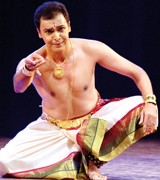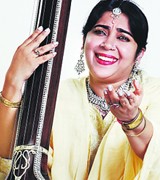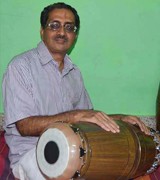COVER STORY
THETAKUDI HARIHARA VINAYAKRAM
SAMUDRI

Among the senior ghatam vidwans of southern India, Vinayakram has enjoyed a long and successful career as a professional musician. In playing the ghatam, he has evolved a style, which though rooted in the conventional technique, is highly individual in spirit. His is also a style that is responsive to other systems of music, accounting for his success with Western ensembles. He has exhibited his improvisatory genius playing complex rhythms for various fusion groups such as Shakti, and for J.G. Laya—an experimental group of musicians including pianists and percussionists.
Vinayakram was born on 11 August 1942 at Tiruchirapalli in Tamil Nadu. He received his training in playing the ghatam initially from his father T.R. Harihara Sarma, and later systematic instruction in the art at the Sri Jaya Ganesh Tala Vadya Vidyalaya, Chennai. He made his concert debut at the age of 13. As a ghatam accompanist, Vinayakram has performed with a host of eminent Carnatic musicians.
SPECIAL FEATURE
SEASON 2016-17 - THE MUSIC ACADEMY DANCE FESTIVAL
Leela Venkataraman

The annual Dance Festival of the Music Academy, Madras (this being the eleventh) has over the years become a landmark event of the “Chennai season”. A welcome change this year was the larger audience turnout for the morning sessions also. The uniformly high standard of music accompaniment was another feature—with singers of the calibre of Radha Badri, D.S. Srivatsa, Srikanth Gopalakrishnan, K. Venkateshwaran, Hariprasad, Rupa Kumar Parida, Changnasseri Madhavan Nampoothiri and Jatin Sahu (for Nrityagram), with nattuvangam by the likes of Adith Narayan, D.V. Prasanna Kumar, Srilatha.S, Jayashree Ramanathan, K.S. Balakrishnan, Dr. S. Vasudevan, and percussionists like Nellai D. Kannan, Ramesh Babu, Vedakrishnaram, Saktivel Muruganandan, Nellai A. Balaji, Satish Krishnamurthy, Lingaraju, Karthikeyan Ramanathan, not excluding the most melodious flute and violin players. In fact, foreigners in the audience wanted tapes of the music and often asked me where they could buy them! Dancers now clearly realise that good music is the greatest investment for a Bharatanatyam performance.
Male dancers impress
This has been the year of the male dancer. Hard to think that traditional Bharatanatyam as performance was meant for women alone, with the male as teacher—presiding over dance recitals as the nattuvanar. How often have we not, over the last fifty years, heard male dancers complain about the prejudice shown by patrons and festival organizers?
INTERVIEW
SOMA GHOSH
Soma Ghosh in conversation with Shrinkhla Sahai

Vocalist Dr. Soma Ghosh believes in alchemising nostalgia into dreams. She wants to go back to the past to envision a healthy future for Hindustani classical music. She brings with her that old world charm, her gayaki reminiscent of the purana andaz with all its adaa and nakhra. “I live in today’s world, but I want to return to that world of music where the soul used to speak,” she says.
Touched by her soulful music, Bismillah Khan declared Soma Ghosh his manasputri (honorary daughter) and they went on to do a number of jugalbandi concerts together. In a letter to the government many years ago, the Ustad wrote that though he had never asked for anything for anyone, he felt that if his daughter received the Padma award it would be a step forward for the world of music. Soma Ghosh received the Padma Shri in 2016. She believes that the award was due to his blessings and the training of her gurus.
INNOVATION
The ethical mridangam
K. Varadarangan in conversation with R. Ramkumar

In his pathbreaking work in the field of Carnatic percussion, Dr. K. Varadarangan, a Bengaluru-based vocalist, musicologist and wireless design specialist, has created a mridangam sans animal skin. In this conversation with mridangam artist R. Ramkumar, he explains how the “SRI mridangam” not only saves animals and trees but also provides tremendous advantages over the conventional mridangam.
What is the SRI mridangam made of? How is it different from a conventional mridangam?
The SRI mridangam is made of a fibreglass shell and synthetic drumheads. The drumhead material is a polyester film and the karane (saadam or soru—the black patch) is made with a special type of rubber. This is different from the conventional mridangam made of wood for the shell and animal skins for the drumheads, and the karane using boiled rice, iron oxide powder and a few other ingredients.


